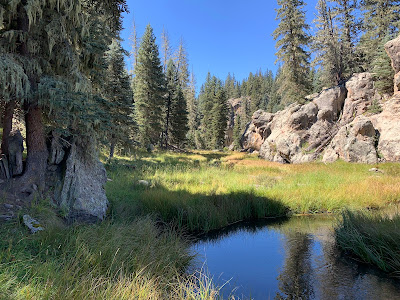1.25 million years ago, a volcano erupted near present day Los Alamos, New Mexico. What remains today is a 13.7 mile diameter circular space called a caldera (from the Spanish word for cooking pot). This is the result of the magma emptying out of a volcano, collapsing the surface. It’s sort of like a crater, but closer to a sinkhole. Known as Valles Caldera today, much of the area has been preserved by the National Park Service.
This vast basin (elevation over 8,000 ft) consists of some flat grassy valleys (valles in Spanish) surrounded by ridges that are over 11,000 feet high and a scattering of hills called resurgent domes where the magma had bubbled back up after the volcano collapsed. The caldera has historically been teeming with wildlife so was well know to Native Americans. One benefit of the volcanic activity was the creation of obsidian (volcanic glass). Now known as Jemez Obsidian, it was used to make exquisite arrow heads and was traded throughout the Southwest for centuries. With a wide variety of landscapes, this region has been used for the filming of a number of movies as well as the TV show Longmire.
We explored the largest valley called the Valle Grande and then hiked along the East Fork of the Jemez River which drains the valley. Leaving the grassy plains, we suddenly found ourselves in a magical little canyon. Once again, the presence of water makes all the difference.
We concluded our day with a late lunch in Los Alamos. With Jeff driving, I enjoyed a special treat at the pub. They had my favorite beer (also that of friend, Clark) on tap; Left Hand Milk Stout Nitro. A glorious end to a glorious day!







No comments:
Post a Comment